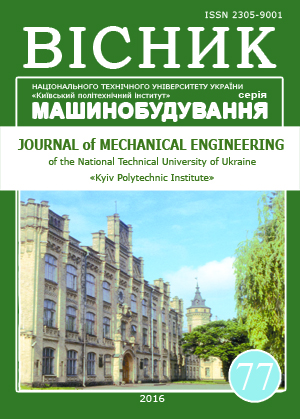EFFECT OF KINEMATIC OF SCREWING ON QUALITY OF THREADED CONNECTIONS
DOI:
https://doi.org/10.20535/2305-9001.2016.77.65482Keywords:
Self-Drilling Thread-Forming Screws, screw connections, force of the thread-formationAbstract
Purpose. Research of the influence of the process parameters on the quality of threaded connections, notably, thread formation axial force on the opposite sides of the roots. Determination the thread formation axial force for screws with a wide groove. Design/methodology/approach. In a paper it is shown, that action of uncompensated thread formation axial force increases the defects and imperfectness of the strengthened layer. Proposed the theory about changes in the traditional self-stretching thread-formation method on the implementation process with a constant axial force. The external axial load must be equal to the largest axial component force of the thread-formation. The method uses the slip-line method with a model taking into account the interaction between two consecutive formed threads and enables the mean pressure on the thread flank to be obtained as a function of the formed thread height. From these results and a knowledge of the forming screw end geometry, an analytical method is proposed for the maximum axial force, the physical phenomena of the displacement of material in the tapping process is illustrated and the significantly influential parameters highlighted. Findings. This study proposes an analytical model based on a previous study concerning radial penetration of a rigid acute wedge into a perfectly plastic material. An experimental study seeks to determine the optimal lead hole on the work piece for an M8 screw. The experimental results are compared favorably with the results of the analytical study in order to validate the forming screw model. Originality/value. It is shown the influence of the geometrical parameters of the thread forming screw and of the work-piece on the axial force, and the influence of the process parameters on the quality of threaded connections. This sets limits on the forming axial force and conserves a sufficiently well formed thread shape for good stripping resistance. The experimental results are compared favorably with the results of the analytical study in order to validate the forming screw model.References
Savchenko, V.A. (1990), Improving resource characteristics of the threaded connections of parts of aircraft engines by optimizing the technological parameters: Dis ... Cand. tehn. Sciences: 05.02.08. Мoscow, Russian.
Lukashov, V.A. (1990), Development and research of a methods of forming small-sized tight threaded joints fastening pins in high strength-Al alloys: Dis ... Cand. tehn. Sciences: 05.02.08. Мoscow, Russian.
Petrikov, V.G. and Vlasov, A.P. (1991), Progressive fasteners Engineering, Мoscow, Russian.
Arpentiev, B.M., Zenkin, A.S. and Kuzin, A.N. (1994), Mekhanyzatsiya i avtomatizatsiya sborochnikh rabot na mashinostroitelnikh predpriyatiyakh [Mechanization and automation of Assembly works in machine-building enterprises], Tekhnika, Kyiv, Ukraine.
Berezin, S.Ya. and Romanova, L.S. (2013), Asymmetry of Structural Extrusion When Forming Smooth-Threaded Connections, Uchenye Zapiski of Zabaikalsky State University. Series Physics, Mathematics, Engineering, Technology, pp. 7-13.

